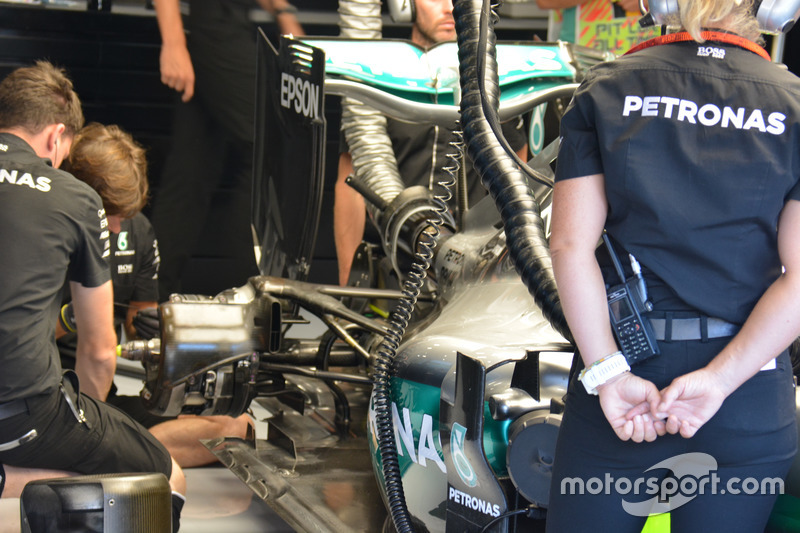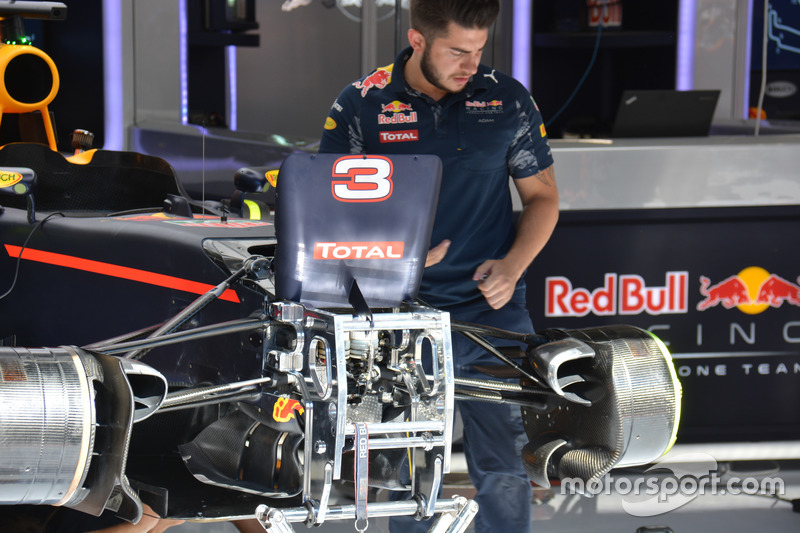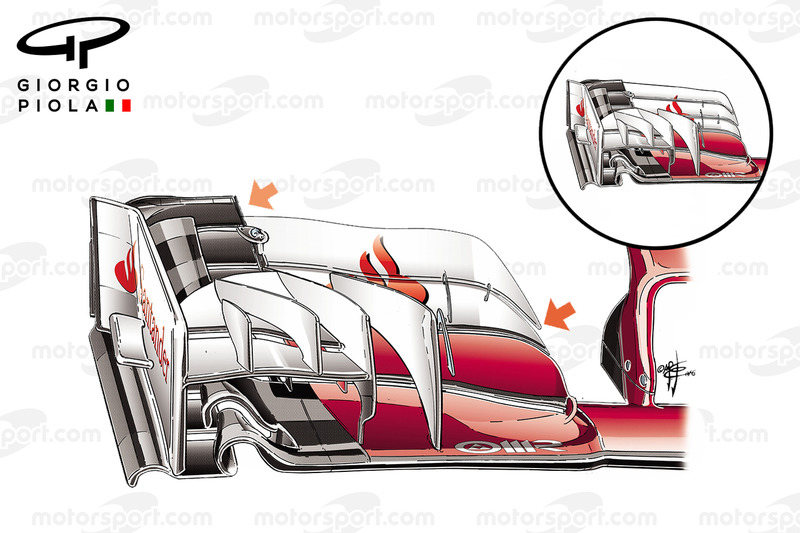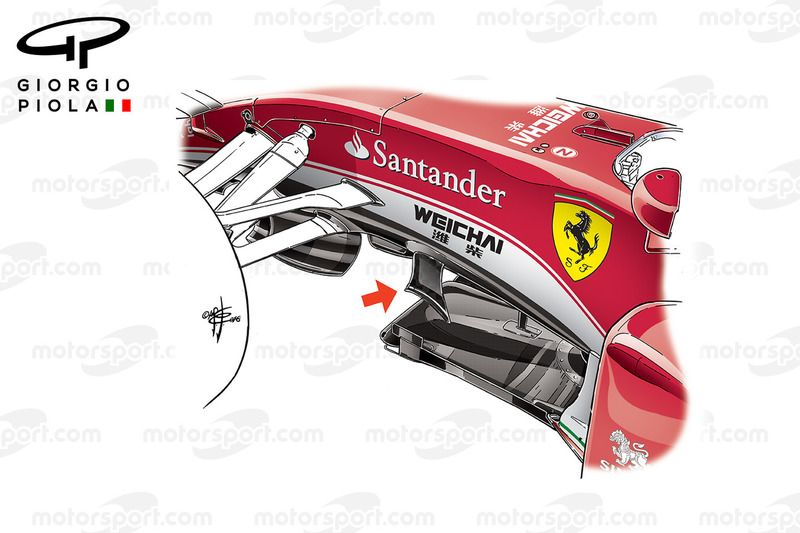Tech debrief: How downforce levels closed up Belgian GP fight
The fight at the front of the Formula 1 field in Belgium was closer than it had been for some time - perhaps as the result of teams needing to carefully balance out downforce/drag levels.

Photo by: Giorgio Piola
Giorgio Piola's F1 technical analysis
Giorgio Piola is the preeminent Formula 1 technical journalist. View our full selection of Giorgio's technical illustrative content
Mercedes
Mercedes' use of the regulations in order to place three additional updated power units into Hamilton's allocation was not only exceptional work from the mechanics, with a new unit being used in each free practice session, but also puts Hamilton in the box seat going forward.
Both drivers took advantage of new parts, with five tokens being used to improve the power unit. Whilst Rosberg used one from his allocation, the three used by Hamilton means he has a significant mileage advantage going into the latter stages of the season, as the German is effectively a power unit adrift.
Outright power unit performance is often forsaken in order to extend mileage too, meaning that in wheel-to-wheel action or during qualifying Hamilton has an advantage whereby he may be able to use more aggressive engine modes for an extended period of time.
Mercedes took advantage of Hamilton's limited running and bedding-in of a new power unit during FP1 to make sure the Monza specification rear wing worked as expected and trial a new rear suspension set-up.
It is our understanding that this suspension set-up is not directly aimed at improving the W07, rather an early test for the additional loads that will be generated in 2017.
However, the team may use what it has learned to improve the car for the rest of the season with another shakedown of the configuration scheduled for Monza.
Lest we forget that Mercedes was one of the teams that suffered failures in Austria and has continued to run additional strengthening and tape on the rear upper wishbone.
So, this may be a case of the team indirectly learning from the build of its mule car or investigations into the W08's design rectifying any current underlying issues.
Mercedes felt threatened by the pace of its rivals on Friday, whilst its drivers weren't entirely comfortable with the balance of the car and performance of the tyres either.
As such, on Saturday the team took the decision to swap out its monkey seat design, trading the hooped version with the more conventional square edged design usually used when running in a higher downforce configuration.
The team has also repurposed the lower downforce wing that made its debut in Baku that features the imposing spoon styling. The 'spoon' wing is used as it provides a significant portion of downforce in the central section but due to the shorter chord height at the outer sections the drag penalty is lessened.
Clearly the pairing of the 'Spoon' wing and square edged monkey seat wasn't planned but the unique challenge that Spa provides meant the configuration needed to be changed to maximise performance in the trickier middle sector.
In order to protect itself from the issues of last season, Pirelli had decided to increase the operating pressures for Spa, something that didn't agree with many of the teams and drivers.
It seemed to throw a rather large spanner in the works for Mercedes too, as with the addition of extremely high track temperatures it struggled to get the type of consistency it'd like and as already mentioned it found itself having to add more downforce.
On the grid it found itself doing something outside of its normal protocols, with the heating devices usually placed over the brake drums nowhere to be found. This emphasises the importance of the relationship between heat and pressure, with Mercedes keen to manage this as best it can to improve performance.
Red Bull
Red Bull's aerodynamic changes have been relatively subtle this season with much of its recuperation of pace in comparison to Ferrari and Mercedes coming from mechanical set-up and the 2016 version of Renault's power unit and its better understanding of how to deploy the energy available, be it petrochemical or electrical.
Suspension
Red Bull focuses a lot of its attention on improving its performance through mechanical set-up changes and keep prying eyes from seeing what it is up to with its vanity panel so that it hides what it is adjusting.
Front brake duct
Over the last few GPs Red Bull seems to have been paying meticulous attention to the clearance of the front brake duct, such is the critical nature of the proximity of the appendage to the tyre.
The measurement and angle of the fins attached to the main vertical fence have also been under scrutiny with the crew taking measurements to ensure they are placed as needed, without infringing the regulations.
Front Wing
For Spa the team had several front wing configurations available to it, one of which featured a new cascade arrangement.
The new specification wing featured a main cascade that has been made wider, whilst the endplate is twisted further outward. To supplement this the winglets that are ordinarily mounted on the side of the main cascade have been revised and a 'r' shaped endplate placed alongside to further assist in moving air across and around the front tyre improving flow downstream.
The new wing wasn't raced though, instead the drivers opted for a wing like the one used in Baku, whereby the upper flap had been cut down significantly to try and take some load off the front axle and reduce some drag.
Rear Wing
Trimming out the front wing needs balancing at the rear of the car too and so it came as no surprise that Red Bull ran with perhaps the lowest downforce rear wing in the field.
Not only were they running with short chord flaps and much less angle of attack, they also revised the endplates to feature just two louvres, one of which is conjoined with the leading edge tyre wake slot.
Ferrari
Coming out of the summer break Ferrari knows that its championship challenge is now about trying to beat Red Bull to second place. Arriving at Spa it didn't have many new parts but worked hard on mechanical set-up and made several changes in specification to improve performance nonetheless.
The mixture of straights in Sectors 1 and 3 and tight twisting corners in Sector 2 poses a challenge for all the teams and often leads to a compromise in terms of set-up.
However, Ferrari seemed to understand this challenge more than most and made several aerodynamic concessions before action had got under way, before shrinking back to establish a baseline that would help during the race.
Front Wing
Like its closest rival Red Bull, the Scuderia had several front wing options available to it in Spa. Both were wings that it had run at the last high speed round in Baku, with the regular three upper flap configuration cut back to shorten the chord length of the uppermost flap (inset).
Meanwhile, the wing touted for use at Baku with two upper flaps but not used at the European GP as it wanted more front load to assist in the tight middle sector, was favored around the 7km Spa-Francorchamps circuit. The two-flap configuration is shorter than the other configuration overall (upper arrow), whilst the tips are clearly different too (lower arrow).
Blown axle
Ordinarily, airflow taken in by the brake duct inlet is sent off in various directions, cooling the brake components. Some of that airflow feeds the hollow axle and is pushed out into the path of the wake shed by the rotating wheel and tyre but for Spa the team decided that this may be too destructive to the floor downstream and blanked off the aperture.
Ferrari has used a blown axle now for a couple of seasons and rarely strayed away from using it having considered it an intrinsic part of their philosophy. Given the recent infrastructure changes in the wake of James Allison's departure it's interesting that these kind of changes have been made, especially as the change in direction appears to have been beneficial, for Spa at least.
Chassis Winglets
In a similar move, the chassis winglets introduced at the British GP (arrowed) were removed for Spa, with the team clearly eager to revise the way in which air moves around the car. These winglets are fine at circuits that demand more downforce but are considered disruptive as speeds escalate.
Rear Wing
On Friday during FP1 and FP2 both drivers were using the low-downforce wing last seen in Baku. However, having taken stock of the situation the team reverted to the higher downforce wing used in the preceding rounds. This wing features larger flaps and more louvres in the endplates to counter the additional drag that is inevitably created.
Diffuser
In recent races the Scuderia has focused its effort on the outer sections of the diffuser, adding a new footplate winglet in order to improve the relationship between it and the deformation of the tyre alongside it.
However, in Belgium the team turned its attention to the central portion of the diffuser, changing the trailing edge shape (see yellow line which portrays the bevel) and with it the angle of attack.
On top of this, the crash structure winglet was also revised, which combined will change the shape of the upwash and in-turn how it interacts with the aerodynamic devices above it.
Be part of Motorsport community
Join the conversationShare Or Save This Story
Subscribe and access Motorsport.com with your ad-blocker.
From Formula 1 to MotoGP we report straight from the paddock because we love our sport, just like you. In order to keep delivering our expert journalism, our website uses advertising. Still, we want to give you the opportunity to enjoy an ad-free and tracker-free website and to continue using your adblocker.






























Top Comments